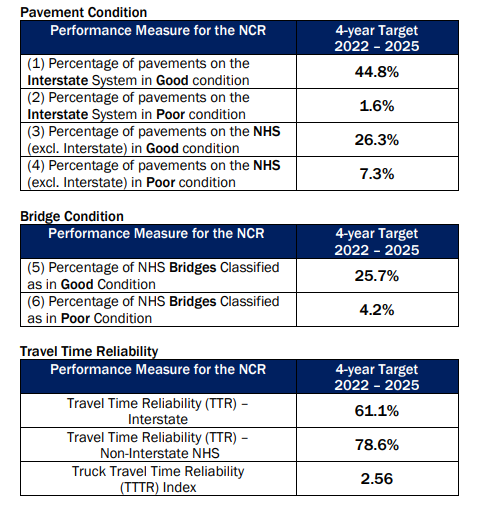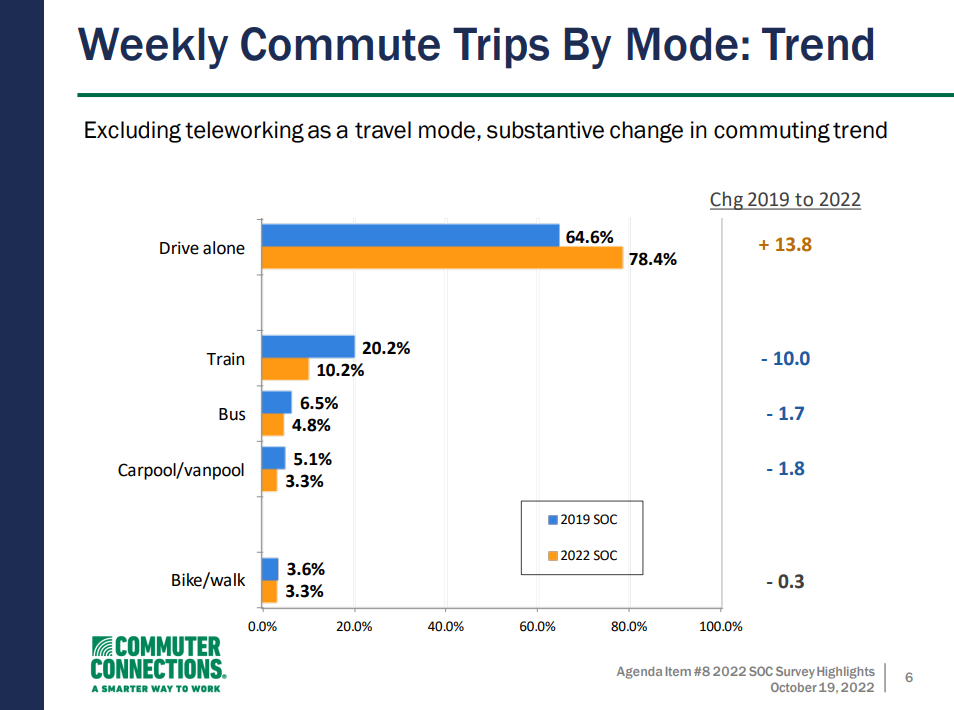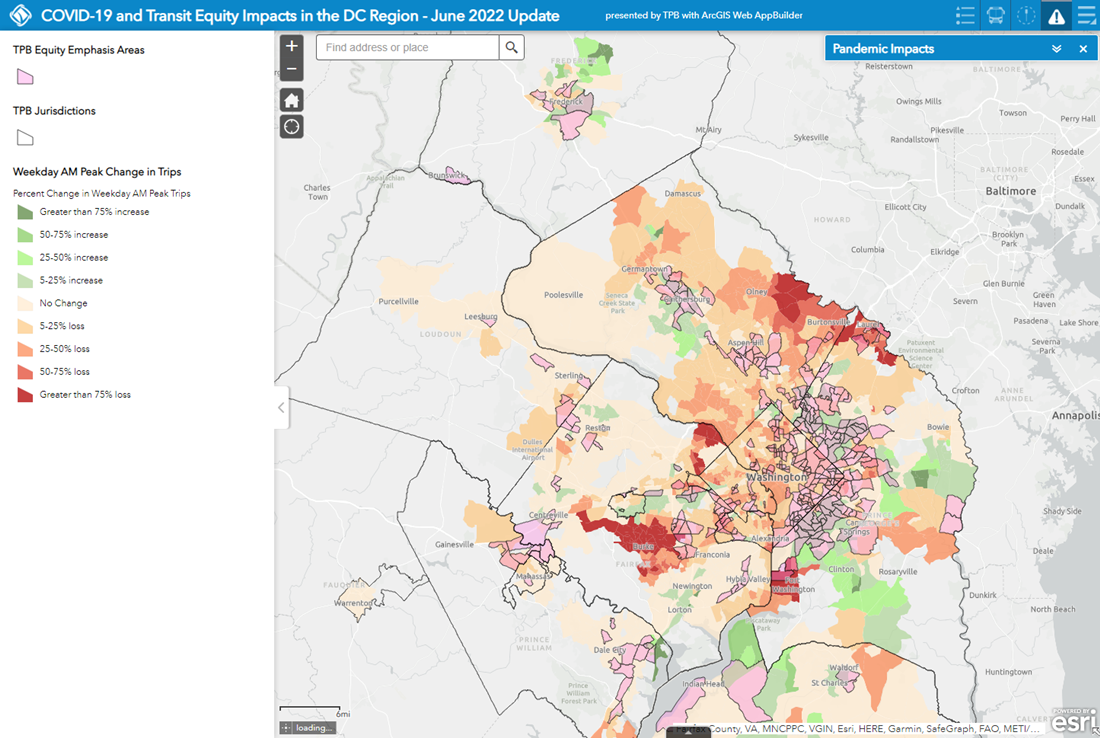At its October meeting the TPB approved a resolution to adopt regional 2022 – 2025 highway systems performance and highway assets (bridge and pavement condition) targets. In addition, board members received updates on the 2022 State of the Commute Survey, the 2022 Bus Equity Update and accompanying webmap tool. The last agenda item was a staff report on major activities and considerations related to the 2024 update to the region’s long-range transportation plan and FY 2025-FY 2028 Transportation Improvement Program (TIP).
Meeting agenda, materials, and recording.
ACTION ITEM
2022-2025 Regional Targets for Highway Systems Performance and Highway Assets
At the October meeting, the TPB adopted Resolution R3-2023 to approve a set of four-year targets. Under Federal Highway Administration regulations, both state DOTs and MPOs establish targets. The TPB works in conjunction with DDOT, MDOT, and VDOT to ensure that targets are evidence based, consistent with targets submitted by each member state DOT, and reflective of the outcomes expected through the implementation of funded projects, programs, and policies.
The September 2022 TPB meeting recap included a description of the regional targets for bridge and pavement conditions for the Interstates and National Highway System (NHS), for travel time reliability for the Interstates and NHS, and for truck travel time reliability on the Interstate System. Local roads and bridges are not included in the target setting.
The following set of four-year regional Highway Asset and Travel Time Reliability targets for 2022-2025 for the National Capital Region are the final targets included in the adopted resolution.

INFORMATIONAL ITEMS
2022 State of the Commute Survey
Nicholas Ramfos, TPB Transportation Operations Programs Director, presented findings from the latest State of the Commute Survey Report, which was also featured in an early September COG news release. The survey of employed persons in the region is conducted every three years, and the 2022 results reflect the coronavirus pandemic’s influence on the rise of telework and transportation mode choice.
Key takeaways from the survey results:
- 60 percent of surveyed workers started or increased telework (32 percent shifted to full-time telework) from 2019 to 2022.
- Almost 1 in 10 survey respondents changed their travel mode on the days they commute.
- Almost 3 in 10 survey respondents made changes to their work arrangements.
- Driving alone increased between 2019 and 2022 while other modes (train, bus, carpool, vanpool) experienced decreases.
- Key reasons for commute changes included:
- coronavirus pandemic
- limited transportation service and schedules
- new job or transit was not available to job location
- transportation service takes too much time or commuter wanted flexibility
A sharp increase in teleworking is evident from the survey responses. The region experienced a nearly fivefold increase in telecommuting since 2019, and 44 percent of all workers who responded to the survey indicated that they were telecommuting on a typical workday. Frequency of telework had tripled since 2019 from 1.2 days per week to 3.4 days per week.
Another key area that TPB members reviewed and discussed was commute satisfaction by mode. Commuters who carpooled, vanpooled, or drove alone reported having the most satisfaction in 2022. Lower satisfaction was reported for public transportation, including commuter train, rail, and bus transit.
Next steps for the survey include preparation of a final public report and preparation of topic summary brochures for distribution.
In an open discussion, TPB members commented on how commute trends that surfaced during the pandemic may have an effect on future surveys. Emerging trends include an increase in use of electric vehicles, new commute routes and times that stem from telework patterns, reexaminations of transit service, and commute effects on greenhouse gas emissions.
Fairfax County Supervisor James Walkinshaw noted that the telework days of the week are a core issue because of the transportation service coordination challenge that result in the region. As a specific example, Virginia Railway Express experiences high demand mid-week, but ridership drops on Mondays and Fridays. Addressing these concerns will be ongoing as the TPB member jurisdictions evaluate the long-term effects of increased telework.

(Commuter Connections/TPB)
2022 Bus Transit Equity Analysis Update
Eric Randall, TPB Transportation Engineer, reported an update to a 2021 analysis of local bus transit in the region. The analysis evaluated the locations of select population groups (e.g., people of color, low-income households, nonnative English speakers) in relation to local bus transit stop locations, frequency of service, and other factors such as car ownership and number/type of jobs.
Key takeaways
- 60 percent of the total population in the TPB region is within ¼ mile of fixed-route bus service.
- 65 percent of people of color and 74 percent of low-income households are within one-quarter mile of bus stops.
- 35 percent of the total population of the TPB region and 43 percent of low-income households have access to 15-minute or better service during the A.M. peak period. A low percentage of access to frequent service for all groups is a concern for quality of life and jobs access.
The 2022 Bus Equity update also includes a webmap tool that includes the following layers:
- Current Transit Service – current bus routes
- Distribution of Transit Service – how near or far people are from existing local transit service
- Network Job Accessibility – total jobs accessible within a 45-minute bus trip from all points in the region
- Pandemic Impacts – how local bus service has changed in terms of use, frequency of service, and route revenue hours
- Index Analysis – combines results from multiple layers to illustrate which areas with high transit equity need lost the most service
The following screenshot shows a pandemic impact layer illustrating the percent change in weekday A.M. trips. Red shading shows areas of loss, and green shows areas with increases.

OTHER TPB AGENDA ITEMS
Long-Range Transportation Plan Update
Stacy Cook, TPB Transportation Planner, presented preliminary activities and considerations for the 2024 Long-Range Transportation Plan Update. In August 2022, the TPB’s federal partners approved the conformity determination for the Visualize 2045 update and the FY 2023-FY 2026 Transportation Improvement Program (TIP). The conformity approval “resets the clock” for the next plan to be approved no later than August 25, 2026. The TPB is working toward updating and approving the plan prior to 2026.
As part of the update, TPB staff will update non-transportation elements such as land-use and demographic assumptions, revise financial plans through 2050, establish new motor vehicle emissions budgets, and re-examine and resubmit projects, programs, and policies.
Preliminary work on the update begins this fall in preparation for key milestones to be completed in Winter/Spring 2023. It is anticipated that a public comment period will take place in summer 2023 with response and update based on comments in fall 2023. TIP inputs and the air quality analysis are slated for spring 2024 with a final plan update, followed by a plan update approval request in late fall 2024.
The schedule is still under discussion and subject to alteration. A complete preliminary schedule and details are available under Agenda Item 10 on the TPB October meeting page.
Committee and Director’s Reports
TPB Technical Committee Meeting – The October meeting focused on the regional highway systems performance and highway assets targets, the 2024 long-range transportation plan update, TPB’s public participation evaluation, and national electric vehicle infrastructure plans.
TPB Community Advisory Committee Meeting – The October CAC meeting included a CAC member public participation focus group discussion as part of the public participation evaluation. In addition, CAC members discussed the committee’s structure, role within TPB, and thoughts about future engagement of CAC members.
CAC Membership Application Period - The TPB is now accepting applications for the 2023-2024 CAC through December 5. For more information, visit the CAC committee page.
TPB Steering Committee and Director’s Report – The October report included TIP amendments, a copy of the final letter that the TPB submitted to the federal docket on September 29 providing comments on the proposed “National Performance Management Measures; Assessing Performance of the National Highway System, Greenhouse Gas Emissions Measure,” and letters of support for TPB member jurisdiction grant applications.
In addition, it was announced that the TPB has received two grants from the Federal Transit Administration under the Innovative Coordinated Access and Mobility (ICAM) program and the Enhancing Mobility Innovation (EMI) program. The ICAM grant, which is supported by matching funds from WMATA, will be used to convene a consortium of regional stakeholders to move the existing Reach a Ride platform towards a one-call, one-click Information and Referral/Assistance tool for transportation options in the region. The EMI project will design an open-source cross platform mobile application to convert existing and future vanpools into microtransit providers to provide additional mobility solutions to traditionally underserved communities. Matching funds for the EMI project are provided by the District, Maryland, and Virginia departments of transportation.
NEXT MEETING
The next TPB meeting is scheduled for November 16 at 12:00 P.M. The November meeting will be in person. A YouTube livestream option will be available. A Work Session on Transportation Safety will be held from 10:30 – 11:45 A.M., which will feature presentations from DDOT, MDOT, and VDOT. The work session will also be available via livestream.